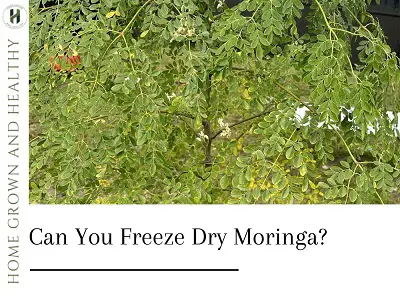The moringa tree (moringa olifera), has been called “The Miracle Tree”1 by many for good reason. All parts of the tree are packed with vitamins, minerals, and nutrients2 which I’ll explore below.
It turns out, different preservation methods for storing moringa have been explored3 and it turns out that freeze drying moringa is the winning technique for preserving all of the nutritional value.
Follow along as I try it myself; I grew my own moringa tree, trimmed it, freeze dried the trimmings, and made powder. We’ll explore the taste, some discussions on yield, and give a final verdict at the end.
Moringa Nutrition
If you go to your friend Google and type in a search query like “moringa nutrition”, you’ll likely come away with the following quote:
Moringa is said to provide 7 times more vitamin C than oranges, 10 times more vitamin A than carrots, 17 times more calcium than milk, 9 times more protein than yogurt, 15 times more potassium than bananas and 25 times more iron than spinach.1
Though you’ll probably find something similar to the above quote all over the internet, most of the citations lead to different papers that keep citing each other. I followed quite the rabbit trail to try to find the source, and it seems that the trail ends at the book I cited by an author named Lowell J. Fuglie of the National Council of the Churches of Christ in the United States of America Church World Service. I cannot find credentials for him and I cannot find a copy of the above cited book to read, so I eventually gave up and moved to a more direct search.
A wonderful review paper was published in 2020 that answered my questions (objectively, with real numbers) about the actual nutrition, gram by gram, contained in moringa leaves specifically.2 For the sake of brevity, I will reproduce the exact chart from the article below:

I did note some interesting things from the chart above, but overall, the information from this review article is great.
- The protein content in the dry, moringa leaf powder is incredibly high. 27g of protein per 100g of powder is on par with any protein supplement.
- The amount of sulfur (“S” in the chart) is surprisingly high. This likely explains why the moringa is sometimes referred to as the “horseradish tree” or the “cabbage tree”.
- If the B vitamins are really in mg in both columns, you can almost ignore them because they are less than 1mg in most cases in fresh leaves. I’m also not sure why choline is 423mg in fresh leaves and not measured in dry leaf powder.
- Vitamin C as reported in the review doesn’t make sense. The chart says there is 220mg vitamin C in fresh leaves but 17.3 (mg?) in dry leaf powder. I’m not sure if this was a typo on the original chart or not.
- If you refer back to the classic quote I referenced at the beginning… “7 times more vitamin C [in moringa] than oranges”, It’s not exactly true (comparing fresh leaves to an orange) but it’s close.
- According to the USDA3 there are 59mg of vitamin C (ascorbic acid) in a 100g orange. Our chart reports 220mg vitamin C in 100g of fresh moringa leaves, so there’s really about 3.5 times more vitamin C than an orange. It’s not 7 times as widely reported, but it’s still much more.
- Looking now at milk in the same way, the USDA4 reports that 100g of 2% (fortified) milk contains 126mg of calcium. Our chart reports 440mg of calcium in 100g fresh moringa leaves (and a whopping 2 grams in dry powder!). So, to again compare fresh leaves with the same amount of milk, the classic quote says there’s 17 times more calcium [in moringa] than milk, but we again end up at about 3.5 times more. If the 2 grams of calcium in dry moringa powder is correct, then there’s about 16 times more calcium in moringa than the same amount of milk and the quote is spot on!
- Next, I compared our original quote “15 times more potassium [in moringa] than bananas” to our chart. We find 259mg of potassium (K) in fresh leaves and a whopping 1324mg K in dry leaf powder. The USDA5 reports that a 100g banana has 326mg K. Our original quote when comparing fresh leaves to the same amount of banana (67mg LESS) or dry leaf powder (4 times more) is significantly less than the reported amounts. Dried moringa leaf powder (100g) compared to the same amount of banana does contain more potassium, but only 4 times more. Fresh leaves (100g) actually contain less potassium than the same amount of banana.
- Last, I compared our original quote “25 times more Iron [in moringa] than bananas” to our chart. Unfortunately, our study only reported minerals generally and didn’t break them out so I’m unable to make a comparison.
- Leucine, isoleucine, and valine (usually referred to as BCAAs) seem incredibly high. If this chart is correct, there are 9.3g leucine, 6.3g isoleucine and 7.1g valine in 100g fresh moringa leaves. These amounts are far above the recommended daily allowance (RDA) for these essential amino acids.6
- The RDAs for each are below. I am basing these numbers on an adult weighing 80kg and referencing the same citation as above.6
- Leucine: 1.12g (100g dried moringa leaf powder supplies 8.3 TIMES the RDA)
- Isoleucine: 1.12g (100g dried moringa leaf powder supplies 7.9 times the RDA)
- Valine: 1.12g (100g dried moringa leaf powder supplies 8.9 times the RDA)
- The RDAs for each are below. I am basing these numbers on an adult weighing 80kg and referencing the same citation as above.6
Growing Moringa
Moringa is widely said to be easy to grow. I’ve experienced this first hand. In USDA zone 10, I bought a small sprout that had been planted from a cutting for $5 at the time. I planted it (added a little black cow) in terrible soil (almost 100% sand) and then proceeded to accidentally break the sprout when I planted it.
Turns out, a couple of weeks later, a new sprout grew from a different part of the cutting, and now about 8 months later I have a moringa tree that’s nearly 8 feet tall. I only fertilized with some very basic, slow release 6-6-6 fertilizer a couple of times, and like an Indian I planted some fish carcasses nearby a few times (I have no idea if that did or will do anything, it was mostly just to keep them from stinking up our trash cans.

So, yes. It is extremely easy to grow moringa. At least it was for me this very first time I tried, even after I killed it the first time and it grew back anyway.
Freeze Dried Moringa
Of all of the fruits and vegetables we’ve freeze dried, moringa was by far the easiest. The freeze dry cycle was less that 24 hours total and that was with my usual additional drying time added. It probably wasn’t necessary.

You can see above, I chose to harvest leaves that were mostly green but there’s also some yellow. My kids report that the green leaves taste better and the more yellow they are, they more bitter they become.
Unfortunately, I didn’t get a pre-weight of the harvest moringa. I can only say that I had enough to fill 5 large Harvest Right trays.
If you don’t have a Harvest Right freeze dryer, be sure to check them out below.

Next, I chopped up all the leaves and branches and spread them mostly evenly across the 5 (large size) freeze dryer trays. You can see in the image below:
- Left: Freeze dried moringa still on the tray after the cycle finished.
- Middle: Fresh moringa ready to go into the freeze dryer (my son is sampling the greenest leaves)
- Right: The 5 large trays in the freeze dryer ready to start the cycle.

Finally, you’ll see below that we crammed all of the freeze dried moringa powder into our Vitamix blender, ground it up, and yielded about 3.1 ounces of moringa powder total

If you do the math in my images above, you’ll note that 3.1 ounces of powder is more like 87 grams but the far right image says 82 grams.
I had originally measured the yield in ounces but then realized most nutrition facts are in grams. I had already used some of the moringa powder for recipes and such, but wanted to give a visual of what 100 grams of powder would look like. It would be quite a bit. I didn’t even yield 100 grams of moringa powder in total.
I also ground up the branches with the leaves. I’m not sure what effect that this has on my powder other than I can be pretty sure that there’s more fiber than the leaves would have by themselves.
One last thing that may be helpful. The measuring spoon in the above image is 1 teaspoon (tsp). I found that a normal sized tsp of moringa powder (not heaping or tightly packed) was usually right around 3 grams.
What is the Best Drying Method for Moringa Leaves?
It turns out, the answer to what is the best drying method for moringa leaves has actually been studied.7 Four drying methods were compared:
- Freeze Drying
- Air Drying
- Sun Drying
- Oven Drying
I won’t go into great detail, but the order I listed them above is the preferred order of the ways to dry moringa leaves for further processing with freeze drying as the best and oven drying as the worst.
The authors concluded that the drying method chosen for moringa leaves can significant alter the phytoconstituents (phenolics, flavonoids, vitamin C, tannin, saponin, phytate, oxalate, alkaloid, cardenolides, and cardiac glycosides), antioxidant capacities (reducing power, Fe2+chelating, ABTS •+, DPPH, and • OH scavenging abilities), and enzyme inhibitory (α‐amylase and α‐glucosidase) effects of the leaf
Their conclusion in this study, as we’ve talked about a lot in a lot of our other articles, is that freeze drying is the preferred method to preserve moringa leaves. The other 3 methods listed above can be used, but if you have access to a freeze dryer, that’s the way to do it.
There are some great charts in the study that reveal the drastic difference in the outcomes of things like flavonoids, vitamin C, and antioxidants when comparing freeze drying to oven drying (which is a good surrogate for dehydrating). Many of these chemicals are not heat stable and freeze drying is the best way to preserve them.
Freeze Dried Moringa Powder Taste Test
If you’ve never tried moringa, I like to compare it to horseradish. There’s a reason a lot people refer to moringa as the horseradish tree. The name fits.
The freeze dried moringa leaf powder reminds me a lot of the fresh leaves. I didn’t try the powder alone, but mixed it in a couple of drinks.
Drink 1: 1 tsp moringa powder mixed with some organic xylitol sweetener and a couple of fresh lemons. I really enjoyed this drink. It was calorie free and had a lot of flavor. The lemons really interacted well with the moringa powder and the sweetener finished it off.

Drink 2: 1 gallon reverse osmosis water mixed with 2 packs of strawberry Liquid IV packs and 5 teaspoons of moringa powder. This drink wasn’t as good. Liquid IV is fairly expensive so I didn’t want to keep adding it. The moringa powder seems to be fairly potent. 5 teaspoons in a gallon of water is plenty. I think if I had stopped at 2 teaspoons it would’ve been just right. I was trying to create a strawberry mint type of flavor but it just didn’t get there. I still enjoyed it, but it was basically straight moringa flavor.
Conclusion
After digging into the seemingly wild claims on the internet about the densely packed nutrition in a moringa tree, it turns out that these conclusions are fairly accurate, although the nutrition in fresh leaves compared to dried leaf powder is drastically different.
It was extremely easy, probably the easiest of any fruit or vegetable I’ve done, to freeze dry moringa leaves. They dried quickly and were easily ground to powder in our blender.
However, for 8 months of tree growth from literally nothing to get a full freeze dryer, I didn’t even yield a full 100 grams of powder. This also was increased (and still not 100 grams) by me including the branches in the powder and I’m not sure what effect that that has on the nutritional value in the final product.
Overall, this was a lot of fun. I think, to increase my yields, I will be planting a few more cuttings to increase my crops so I can make more powder. My 87-ish grams of powder won’t last terribly long.
Citations
- Fuglie L. 2001. The Miracle Tree: The Multiple Attributes of Moringa. CTA Publication, Wageningen, The Netherlands. Pp 117-136 in Combating Malnutrition with Moringa.
- Yaseen, Arshad & Takacs-Hajos, Maria. (2020). Study on moringa tree (Moringa oleifera Lam.) leaf extract in organic vegetable production : A review. Research on Crops. 21. 402-414. 10.31830/2348-7542.2020.067.
- Oranges, raw, navels. https://fdc.nal.usda.gov/fdc-app.html#/food-details/746771/nutrients
- Milk, reduced fat, fluid, 2% milkfat, with added vitamin A and vitamin D. https://fdc.nal.usda.gov/fdc-app.html#/food-details/746778/nutrients
- Bananas, ripe and slightly ripe, raw. https://fdc.nal.usda.gov/fdc-app.html#/food-details/1105314/nutrients
- National Research Council (US) Subcommittee on the Tenth Edition of the Recommended Dietary Allowances. Recommended Dietary Allowances: 10th Edition. Washington (DC): National Academies Press (US); 1989. 6, Protein and Amino Acids. Available from: https://www.ncbi.nlm.nih.gov/books/NBK234922/
- Ademiluyi AO, Aladeselu OH, Oboh G, Boligon AA. Drying alters the phenolic constituents, antioxidant properties, α-amylase, and α-glucosidase inhibitory properties of Moringa (Moringa oleifera) leaf. Food Sci Nutr. 2018 Oct 10;6(8):2123-2133. doi: 10.1002/fsn3.770. PMID: 30510713; PMCID: PMC6261129.

